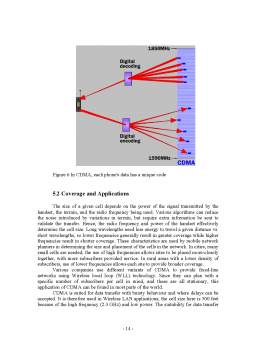Cuprins
- 1.Introduction
- 2.Wireless Communication System Characteristics
- 3. Frequency Division Multiple Access (FDMA)
- 3.1 Overview
- 3.2 Channel Considerations
- 3.3 Influence of Antenna Height
- 3.4 Advantages/Disadvantages
- 3.5 Further Remarks
- 4.Time division multiple access (TDMA)
- 4.1 Overview
- 4.2 Propagation Considerations
- 4.3 TDMA Example
- 4.4 Advantages/Disadvantages
- 4.5 Further Remarks
- 5. Code Division Multiple Access (CDMA)
- 5.1 Overview
- 5.2 Coverage and Applications
- 5.3 How it works
- 5.4 Advantages/Disadvantages
- 5.5 Further Remarks
- 6. Space Division Multiple Access (SDMA)
- 6.1 Overview
- 7. Comparison.Conclusions
- 8. References
Extras din proiect
1. Introduction
The radio channel is fundamentally a broadcast communication medium. Therefore, signals transmitted by one user can potentially be received by all other users within range of the transmitter. Although this high connectivity is very useful in some applications, like broadcast radio or television, it requires stringent access control in wireless communication systems to avoid, or at least to limit, interference between transmissions. Throughout, the term wireless communication systems is taken to mean communication systems that facilitate two-way communication between a portable radio communication terminal and the fixed network infrastructure. Such systems range from mobile cellular systems through personal communication systems (PCS) to cordless telephones.
The objective of wireless communication systems is to provide communication channels on demand between a portable radio station and a radio port or base station that connects the user to the fixed network infrastructure. Design criteria for such systems include capacity, cost of implementation, and quality of service. All of these measures are influenced by the method used for providing multiple-access capabilities. However, the opposite is also true: the access method should be chosen carefully in light of the relative importance of design criteria as well as the system characteristics.
Multiple access in wireless radiosystems is based on insulating signals used indifferent connections from each other. The support of parallel transmissions on the uplink and downlink, respectively, is called multiple access, whereas the exchange of information in both directions of a connection is referred to as duplexing. Hence,multiple access and duplexing are methods that facilitate the sharing of the broadcast communication medium. The necessary insulation is achieved by assigning to each transmission different components of the domains that contain the signals. The signal domains commonly used to provide multiple access capabilities include the following.
Spatial domain: All wireless communication systems exploit the fact that radio signals experience rapid attenuation during propagation. The cellular design principle is based on the ability to reuse signals safely if a minimum reuse distance is maintained. Directional antennas can be used to enhance the insulation between signals.Adaptive antennas also allow a base station to reuse a frequency to communicate with two or more mobiles if the mobiles are separated in angle from the base station.This approach is called space division multiple access (SDMA). By using highly directional beams and/or forming nulls in the directions of all but one of the mobiles on a frequency, the base station creates multiple channels using the same frequency, but separated in space.
Frequency domain: Signals which occupy nonoverlapping frequency bands can be easily separated using appropriate bandpass filters. Hence, signals can be transmitted simultaneously without interfering with each other. This method of providing multiple access capabilities is called frequency division multiple access (FDMA).
Time domain: Signals can be transmitted in nonoverlapping time slots in a round-robin fashion.Thus, signals occupy the same frequency band but are easily separated based on their time of arrival.This multiple access method is called time-division multiple access (TDMA).
Code domain: In code-division multiple access (CDMA) different users employ signals that have very small cross-correlation. Thus, correlators can be used to extract individual signals from a mixture of signals even though they are transmitted simultaneously and in the same frequency band. The term code-division multiple-access is used to denote this form of channel sharing.
2. Wireless Communication System Characteristics
Modern wireless radio systems range from relatively simple cordless telephones to mobile cellular systems and the emerging personal communication systems (PCS). It is useful to consider such diverse systems as cordless telephone and mobile cellular radio to illustrate some of the fundamental characteristics of wireless communication systems.
A summary of the relevant parameters and characteristics for cordless telephone and cellular radio is given inTable 1.
Table.1 Summary of Relevant Characteristics of Cordless Telephone and
Cellular Mobile Radio
In cordless telephone applications the transmission range is short because the base station can simply be moved to a conveniently located wire-line access point (wall jack) to provide wireless network access where desired. In contrast, the mobile cellular base station must provide access for users throughout a large geographical area of up to approximately 30 km (20 mi) around the base station.
The different range requirements directly affect the transmit power and antenna height for the two systems. High-power transmitters used in mobile cellular user sets consume far more power than even complex signal processing hardware. Hence, sophisticated signal processing, including speech compression, voice activity detection, error correction and detection, and adaptive equalization, can be employed without substantial impact on the battery life in portable hand sets. Furthermore, such techniques are consistent with the goals of increased range and support of large numbers of users with a single, expensive base station. On the other hand, the high mobile cellular base station antennas introduce delay spreads that are one or two orders of magnitude larger than those commonly observed in cordless telephone applications.
Preview document
Conținut arhivă zip
- Tehnici de Acces Multiplu.DOC





























